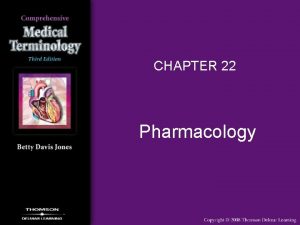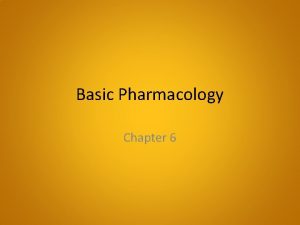Pharmacology An Intro into Pharmacology Pharmacology The study






















- Slides: 22

Pharmacology An Intro into Pharmacology

Pharmacology ● The study of drugs. Two Categories: ● Pharmacokinetics ● Pharmacodynamics

Pharmacokinetics The study of the 4 drug processes of absorption, distribution, metabolism, & excretion, which is commonly referred to as the ADME process

Pharmacodynamics Involves the effect of the drug on the site of action within the body, based on the drug concentration.

Important Vocab & Concepts Drug Interactions Dosage Forms Routes of Administration Drug Classifications & Category Exploration

Drug Interactions 1. Drug- Disease- A medication interacts with a disease or condition 2. Drug- Dietary Supplement- An herbal or dietary supplement interacts with a prescription drug 3. Drug-OTC- An OTC medication can interact with a medication, increasing or decreasing its effects 4. Drug- Laboratory- A drug may affect concentrations of specific laboratory values obtained, requiring additional testing 5. Drug- Nutrient- A drug may affect the levels of certain nutrients in the body

Practice A patient with high blood pressure takes the decongestant Pseudoephedrine and it causes an addition increase in blood pressure. A. Drug-OTC B. Drug-Disease C. Drug-Dietary Supplement D. None of the Above

Practice St John’s Wort can interact with oral contraceptives, making them less effective, causing breakthrough bleeding, or unplanned pregnancy. A. Drug-OTC B. Drug-Disease C. Drug-Dietary Supplement D. Drug-Nutrient

Practice Flagyl, Metronidazole, can interfere with specific enzyme values, causing falsely low results. A. Drug-Laboratory B. Drug-Disease C. Drug-OTC D. Drug-Nutrient

Summed up… Drug Compatibility (What is it? )

Drug Compatibility Inactivation of medications when compounds are physically mixed together prior to administration. Example(s). . . ceftriaxone (Rocephin) and azithromycin (Zithromax) cannot be run through the same IV line as they are incompatible. acetaminophen (Tylenol) and aspirin (Bayer) collaboratively together (potentiation). They are compatible.

REVIEW: DOSAGE FORMS

Dosage Forms Medications are manufactured in many different dosage forms depending on the characteristics of the drug itself. Factors To Decide Which Dosage Form Should be Chosen: Route of Administration Diagnosis of the Patient

Dosage Forms Can Be Divided into (3) Different Categories: Liquids Semisolids Solids

Elixir Liquids Emulsion Enema Inhalant Solution Lotion Solution Spray Suspension Syrup

Cream Semisolids Inhalant Powder Ointment Powder Suppository

Caplet Solids Capsule Lozenge or Troche Patch Tablet

Pregnancy Categories The FDA has Developed 5 categories to indicate the potential of a drug to cause birth defects if taken during pregnancy. These categories are based on risk to the fetus & available data. Categories A-D & X. Category A- no evidence of risk Categories D & X- showing severe risk.

REVIEW: Routes of Administration Inhalation Intramuscular Intrathecal IV Nasal Ocular Oral Rectal Subcutaneous Sublingual Topical Transdermal Vaginal

Therapeutic Equivalence The FDA classifies drug products as therapeutically equivalent if the substituted product will have the same clinical & safety profile as the prescribed product. Therapeutically equivalent products must contain: • The same active ingredient, • Be the same dosage form, • Have the same route of administration, and • Be the same strength. They are then assigned a therapeutic equivalence code which can be found in The Orange Book. (“AB” code is the most commonly seen designation)

Antibiotics ● target bacteria in the body that cause infection. Two Basic Types: ● Bactericidal- work by killing the bacterial cell ● Bacteriostatic- inhibits bacterial growth

Antibiotics Will decrease the effectiveness of oral contraceptives. Can increase the action of warfarin.
 Introduction to business chapter 7
Introduction to business chapter 7 Hình ảnh bộ gõ cơ thể búng tay
Hình ảnh bộ gõ cơ thể búng tay Ng-html
Ng-html Bổ thể
Bổ thể Tỉ lệ cơ thể trẻ em
Tỉ lệ cơ thể trẻ em Gấu đi như thế nào
Gấu đi như thế nào Chụp tư thế worms-breton
Chụp tư thế worms-breton Chúa yêu trần thế alleluia
Chúa yêu trần thế alleluia Các môn thể thao bắt đầu bằng tiếng đua
Các môn thể thao bắt đầu bằng tiếng đua Thế nào là hệ số cao nhất
Thế nào là hệ số cao nhất Các châu lục và đại dương trên thế giới
Các châu lục và đại dương trên thế giới Công thức tiính động năng
Công thức tiính động năng Trời xanh đây là của chúng ta thể thơ
Trời xanh đây là của chúng ta thể thơ Cách giải mật thư tọa độ
Cách giải mật thư tọa độ Làm thế nào để 102-1=99
Làm thế nào để 102-1=99 độ dài liên kết
độ dài liên kết Các châu lục và đại dương trên thế giới
Các châu lục và đại dương trên thế giới Thơ thất ngôn tứ tuyệt đường luật
Thơ thất ngôn tứ tuyệt đường luật Quá trình desamine hóa có thể tạo ra
Quá trình desamine hóa có thể tạo ra Một số thể thơ truyền thống
Một số thể thơ truyền thống Bàn tay mà dây bẩn
Bàn tay mà dây bẩn Vẽ hình chiếu vuông góc của vật thể sau
Vẽ hình chiếu vuông góc của vật thể sau Biện pháp chống mỏi cơ
Biện pháp chống mỏi cơ











































